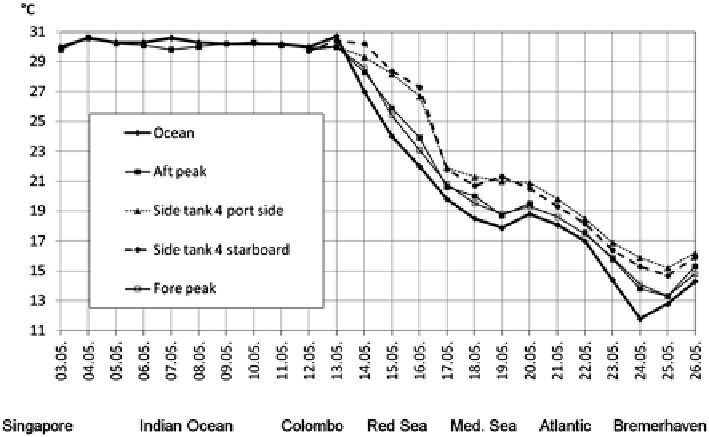Environmental Engineering Reference
In-Depth Information
Fig. 2
Ballast water tank temperatures and sea surface temperatures during a voyage from
Singapore to Bremerhaven (Reprinted from Gollasch et al.
2000a
, copyright 2000, with permission
from RightsLink Service, Oxford University Press)
absence of light and there can be limited resources such as oxygen, food, lack of
shelter and the varying temperatures that may take place during a voyage that may
considerably differ from the ballast water uptake area. Some inter-oceanic ship voy-
ages can expose ships ballast water to wide ranges of temperature between tropical
and temperate regions, this is because the ballast water gradually assumes a similar
temperature to that of the ambient sea surface a ship passes through, as can happen
with passages between the Pacifi c and Atlantic (see Fig.
2
). In winter these changes
can be extreme.
Although voyage duration affects the survival of organisms in ballast water, it is
not a ballast water management option to retain the water onboard for long periods
in order to ensure that all organisms die. Some organisms can survive 3 or more
months between ballast uptake and discharge. In one case, where daily samples of
ballast were taken during a voyage, a crustacean (a harpacticoid copepod), greatly
increased their numbers, and had most probably reproduced inside the ballast tank
during the voyage (Gollasch et al.
2000a
). Some organisms can survive in ballast
sediments for long periods when they develop resting stages. Some phytoplankton
species, in particular dinofl agellates, several of which can generate toxins, form such
resting stages (cysts) which may settle to the bottom sediment in a ballast tank. These
may remain viable (in a dormant state) despite unfavourable conditions from months
to years. This poses a risk since as viable cyst-forming species may be discharged
during deballasting with disturbed sediments after several voyages from their uptake
or with sediments when removed during tank cleaning (Hallegraeff and Bolch
1992
).

Search WWH ::

Custom Search